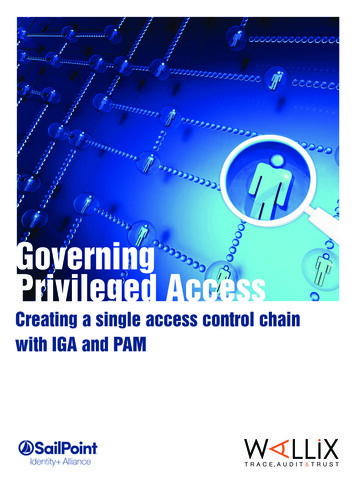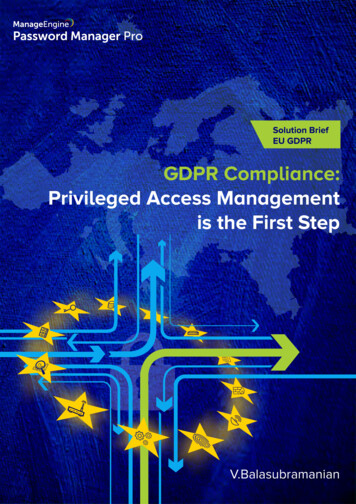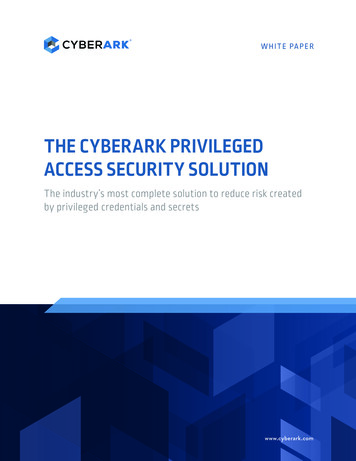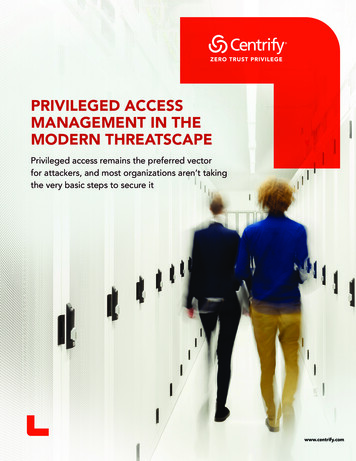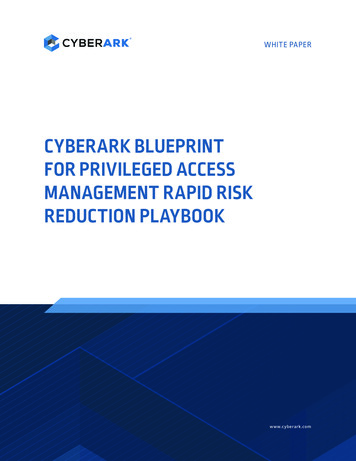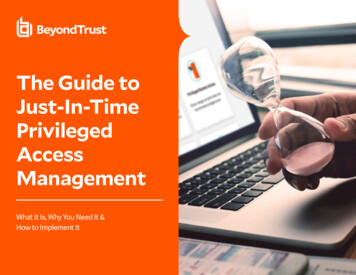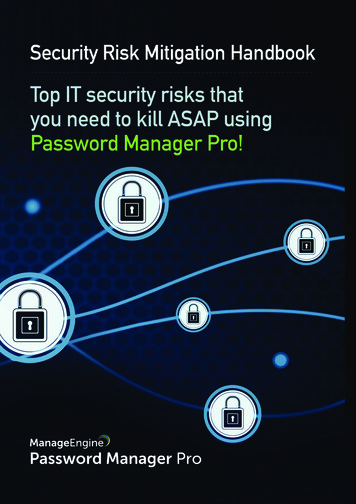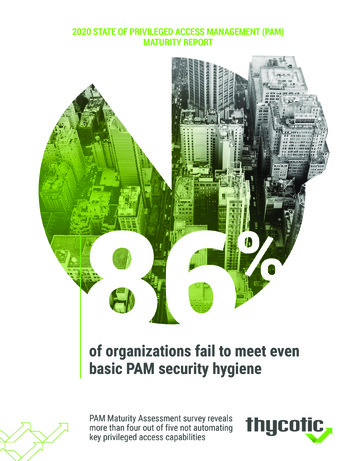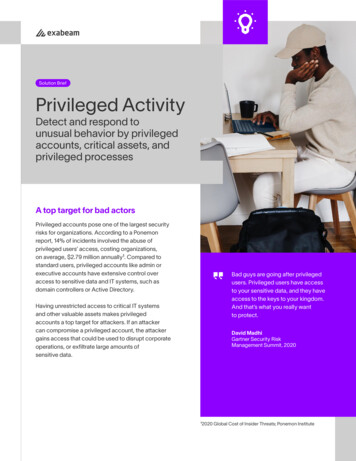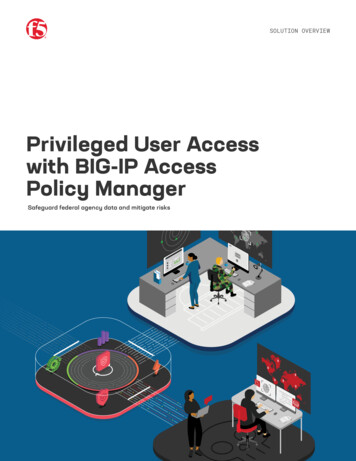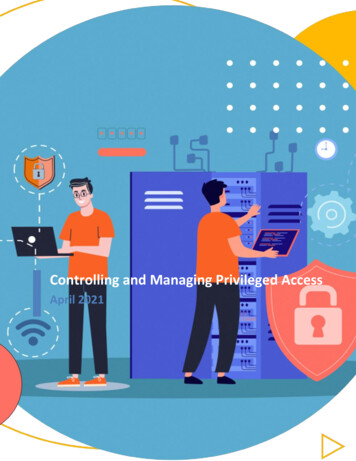
Transcription
Controlling and Managing Privileged AccessApril 2021
Controlling and Managing Privileged AccessTable of ContentsA. A Few Examples of Insider Attacks .3B. Why Insider Attacks Happen .3Reasons Behind Insider Attacks . 4Consequences of Insider Attacks . 4C. Privilege Access Management (PAM) .5D. Types of Privileged Users Accounts .6How Hackers Obtain Privileged Access Credentials . 6Keystroke Logging . 7Password Cracking . 7Memory Scraping . 7Password Spreadsheets . 7Social Engineering . 7Obtaining Application Credentials . 7Other vulnerabilities . 8How Privileged Accounts Should be Monitored . 8Identifying Privileged Accounts. 8Monitoring Keystroke Logging . 8Centralized Passwords Repository . 9Limited Access to Passwords . 9Automatic Password Change . 9Password Policies for Temporary Users. 9Regular Password Audits . 9Password management for employees leaving . 9Principle of Least Privilege . 9E. Summary . 10This document is proprietary and confidential. No part of this document may be disclosed in any mannerto a third party without the prior written consent of 42Gears Mobility Systems1
Controlling and Managing Privileged AccessControlling and Managing Privileged AccessAccording to Felix Gaehtgens, Research Director in Systems, Security, and Risk at Gartner,“Privileged Access Management (PAM) is a crucial component of any security program becauseof the increasingly large scope of IT environments, privileged users, administrative tools, andIdentity and Access Management (IAM) data such as passwords, encryption keys andcertificates.” 1While privileged access accounts are necessary to execute and control organizational operationsand functions, these accounts introduce security risks and securing them is important.Today, with the number of cybercrimes rising and threat actors focusing more on privilegedaccounts, controlling, and managing privileged access accounts has become increasinglychallenging for CIOs and CTOs. Privileged access accounts are lucrative targets for attackers asthey offer easy access to all enterprise assets and data, including files, databases, emails, systems,and applications.Privileged accounts can be targeted by both outside hackers and insiders (such as disgruntledemployees). Insider attacks are considered to be the most dangerous as they can lead todevastating losses. According to a global report2 published in 2020 by the Ponemon Institute,the total average cost of insider-related incidents is 11.45 million USD.Definition of Insider Threat by Computer Emergency Response Team (CERT)3,“A malicious insider threat is a current or former employee, contractor, or business partnerwho has or had authorized access to an organization’s network, system, or data andintentionally exceeded or misused that access in a manner that negatively affected theconfidentiality, integrity, or availability of the organization’s information or informationsystems.”1 20202 3 5/samplepages/9780321812575.pdfThis document is proprietary and confidential. No part of this document may be disclosed in any mannerto a third party without the prior written consent of 42Gears Mobility Systems2
Controlling and Managing Privileged AccessA. A Few Examples of Insider AttacksThere was an insider attack on General Electric4, where two employees stole trade secrets fromthe company's servers. Thousands of files were downloaded and sent to private email addresses.After investigation, the attackers were convicted, sent to prison, and penalized 1.4 million USDto recover General Electric’s loss.Another incident happened at Microsoft5 in December 2019 when the company deployed newAzure security rules6. Employees misconfigured the rules, accidentally leaking a customersupport database containing 250 million entries accumulated over 14 years. The incidenthappened because the database was not protected with a password or two-factorauthentication.Cisco7 experienced a similar incident in September 2018.A former employee gained unauthorizedaccess and deployed a malicious code to the company’s cloud infrastructure, deleting 456 virtualmachines and preventing over 16,000 users from working for two weeks.B. Why Insider Attacks HappenThe most common motivator behind insider attacks is money. According to the Verizon 2019Data Breach Investigations report8, 34% of data breaches in 2019 involved internal actors. While71% of breaches were financially motivated, 25% were motivated by the gain of strategicadvantages or espionage. 29% of breaches involved use of stolen credentials.However, sometimes data breaches may happen simply due to employees' negligence andmistakes. The IBM 2019 Cost of a Data Breach survey9 found that 24% of data breaches werecaused by negligent employees and contractors (human error).4 ft-of-trade-secrets-from-ge-0729205 er-records-exposed-online/?sh 7e9bf0624d1b6 work/network-security-groups-overview7 -pleads-guilty-in-insider-threat-case-a-149178 019-data-breach-investigations-report.pdf9 https://www.ibm.com/downloads/cas/RDEQK07RThis document is proprietary and confidential. No part of this document may be disclosed in any mannerto a third party without the prior written consent of 42Gears Mobility Systems3
Controlling and Managing Privileged AccessReasons Behind Insider AttacksConsequences of Insider AttacksThis document is proprietary and confidential. No part of this document may be disclosed in any mannerto a third party without the prior written consent of 42Gears Mobility Systems4
Controlling and Managing Privileged AccessAs discussed above, the possible consequences of insider attacks may harm organizations indifferent ways. And that is why managing and controlling privileged access accounts is crucial forCIOs and decision makers in organizations of any kind. In this paper, we will talk about PrivilegedAccess Management (PAM), how hackers obtain access to privileged accounts, and how can CIOscontrol and manage privileged accounts better.C. Privilege Access Management (PAM)Companies often provide elevated or privileged access to some employees so that they canaccess enterprise network systems or sensitive data whenever needed. However, the number ofprivileged users varies based on the size of the enterprise. For example, small businesses oftenhave just one privileged account that is allotted to the most trusted person in the organization,whereas medium or large businesses can have multiple privileged users who use the sameprivileged access credentials.Providing elevated access can create problems if trusted employees become disgruntled and planto cheat the organization. That’s precisely why businesses need some kind of mechanism in placeto prevent users from abusing elevated accounts.Additionally, many organizations work with third-party vendors to get their job done, and forthat, these third parties need to access privileged accounts and credentials. Technically, whenthird parties finish their jobs, the shared credentials and account access should be revoked. If thisis not done, they may misuse access rights in the future. Thus, businesses must have a system inplace to revoke access either manually or automatically once the task is done.Also, businesses need to be compliant with certain regulations such as GDPR10, HIPAA, and PCIDSS. Non- compliance may cause serious consequences.Privileged Access Management (PAM) can help businesses deal with all the problems mentionedabove. Privileged access management consists of policies, processes, and mechanisms that helpensure that all privileged users are using credentials in the right way only doing what their jobsdemand. Timely audits are also a part of privileged access management, to ensure thatauthorities can quickly act to resolve any discrepancies.10 -general-data-protection-regulation-gdpr/This document is proprietary and confidential. No part of this document may be disclosed in any mannerto a third party without the prior written consent of 42Gears Mobility Systems5
Controlling and Managing Privileged AccessD. Types of Privileged Users AccountsLet’s see how many types of privileged accounts exist:Privileged User Account: When businesses grant privileged access to any user account beyondthat afforded to a standard account, it is considered a privileged account. Privileged accessaccounts are considered the most dangerous type of privilege access, as they are difficult to shutdown if commandeered by someone with malicious intentions.Domain Administrator Account: These accounts are granted many privileges, including access toall servers, controllers, and workstations. That is why these accounts so frequently become agateway for multiple security threats.Local Administrator Accounts: IT administrators grant privileged access to local machines tocarry out maintenance tasks. Sometimes these accounts are available by default at the OS level(such as in Windows11, where it was available by default until Windows 7). Hackers may leveragethese accounts to look for cybersecurity loopholes to abuse the network and system.System or Service Accounts: System accounts can be privileged local or domain accounts.Applications and services generally use these accounts to interact with the OS, with the accountsproviding privileges based on what the applications and services need. These accounts are riskybecause, more often than not, business executives are unaware that such accounts exist. As aresult, the passwords remain unchanged for years, making such accounts vulnerable.Application Accounts: Applications use these accounts to access organizational networks anddata. Generally, application account passwords are saved in an unencrypted form, or in text files,so that they can be accessed by users whenever needed. This can be a security vulnerability, asattackers may abuse known passwords for malicious purposes.How Hackers Obtain Privileged Access CredentialsIn a CyberArk webinar12, Kevin Naglich emphasized common techniques such as keystrokelogging, password cracking, memory scraping, password spreadsheets and social engineeringthat are used to steal privileged credentials. Let’s take a closer look at all these separate pointsand check some other techniques as well.1311 local-administrator-accounts-part-i/12 https://cyberark.wistia.com/medias/2ttz5d4p6w13 ttackers-try-to-steal-privileged-credentialsThis document is proprietary and confidential. No part of this document may be disclosed in any mannerto a third party without the prior written consent of 42Gears Mobility Systems6
Controlling and Managing Privileged AccessKeystroke LoggingAccording to Tom Bain, former VP of security strategy at Morphisec, “Keyloggers are softwareprograms that leverage algorithms that monitor keyboard strokes through pattern recognitionand other techniques.”. They capture all the keystrokes of user types, including privilegedpasswords, and send them to a third party.Password CrackingNetwork, database, and system admins are generally people who know the entire system andinfrastructure very well. For that reason, it’s easy for them to crack or guess the credentials.Memory ScrapingMemory scraping was declared one of the most dangerous attack techniques by SANS Institute,in 201114. It is malware that looks into the memory of desktops to find personal data, credentials,or other sensitive data that otherwise couldn’t be obtained.Password SpreadsheetsPeople sometimes maintain a list of passwords in spreadsheets, but it could be devastating for abusiness if those spreadsheets fall into the wrong hands. Hackers generally look for spreadsheetsthat contain all passwords so that they can get multiple passwords at once.Social EngineeringHackers sometimes try to get credentials by using social engineering. Here, attackers send anemail or some other kind of communication with a malicious link, with an accompanying urgentmessage. This results in victims promptly clicking malicious links or files. Social engineeringattacks are hard to fully protect against, as they prey upon emotions.Obtaining Application CredentialsEven when companies do a good job of protecting passwords, this is all for naught if they don’tfrequently change those passwords. If companies never change passwords, disgruntled formeradministrators can use them to access sensitive resources years after their departure.14 ics/Memory-scraping malwareThis document is proprietary and confidential. No part of this document may be disclosed in any mannerto a third party without the prior written consent of 42Gears Mobility Systems7
Controlling and Managing Privileged AccessOther vulnerabilities Passwords may be saved in ways that are impossible to track, such as files, spreadsheets,hard copies or print outs. As another example, admins may have circulated multiplecopies of password-containing documents amongst themselves. These things makepasswords vulnerable to exposure and increase the likelihood of someone abusing themfor malicious purposes. Tracing the person responsible for password abuse is difficult in a shared environmentwhere passwords remain impersonal. Failing to remove temporary passwords provided for third-party contractors.How Privileged Accounts Should be MonitoredDecisions makers may not always be aware of the ways privileged accounts can be misused, assuch accounts attract little attention. That’s one of the reasons the number of insider attacks hasincreased significantly in recent years.Insider attacks cannot be prevented or avoided completely; however, devising strong andeffective policies and strategies to monitor privileged accounts can help minimize the frequencyof attempted insider attacks.Here are few ways in which businesses can monitor the privileged accounts:Identifying Privileged AccountsThe first step is to identify the different privileged accounts that exist in an organization, andwhere they are, so they can be monitored and controlled. This can help thwart potential attacks.Administrators can implement a system to send automatic alerts to required personnel if theseaccounts display any suspicious activity.There are a few tools available that can identify privileged accounts15 in your network, and checkif all privileged passwords are being changed regularly, either manually or automatically.Monitoring Keystroke LoggingTo prevent keystroke logging attacks, businesses need to continuously monitor desktop activities.In addition to this, IT managers should be able to monitor what is happening on a screen and15 d urx-40578& ga 949This document is proprietary and confidential. No part of this document may be disclosed in any mannerto a third party without the prior written consent of 42Gears Mobility Systems8
Controlling and Managing Privileged Accessrecord those activities for future reference. Furthermore, managers must be able to monitorkeystroke logging and revoke access at any time (if needed).Centralized Passwords RepositoryAll administrative passwords should be encrypted and saved in a centralized repository to avoidstoring passwords in random places. and make password cracking as difficult as possible.Limited Access to PasswordsAn employee should only be able to access passwords that they are authorized to use. This cannot only minimize the occurrence of attacks but also help identify the miscreant in the event ofan attack.Automatic Password ChangeAll administrative passwords should automatically change (to strong, unique passwords) at fixedintervals. This will make it hard for former insiders to crack passwords.Password Policies for Temporary UsersTemporary users should be allotted passwords that are valid only for a certain period, and onlyon request. Also, the moment the temporary user's job is done, access permissions should berevoked.Regular Password AuditsAll allotted passwords should be audited on a regular basis to check for irregularities and ensurethat privileged account holders aren’t misusing their access rights.Password management for employees leavingIf an employee is leaving the organization, the allotted passwords should be either transferredto some other employee or reset automatically. This helps to avoid password misuse bydisgruntled employees.Principle of Least PrivilegeOrganizations need to adopt the principle of least privilege, which keeps privileged knowledge assafe as possible. Passwords should be allotted as per the needs of each employee and grantedThis document is proprietary and confidential. No part of this document may be disclosed in any mannerto a third party without the prior written consent of 42Gears Mobility Systems9
Controlling and Managing Privileged Accessonly when they are needed. This approach can help organizations avoid privileged passwordabuse.E. SummaryProviding privileged access to privileged or administrator accounts isn’t a problem. However,allowing these accounts uncontrolled access with no monitoring and control may havedevastating consequences for any organization. With technologies evolving and organizationsadopting more technology, we can’t afford to become complacent. Cybercrime and insiderthreats will always come along with such advancements.The good news is that we have solutions like PAM, which is a subset of IAM (Identity and AccessManagement). IAM has a broader coverage and includes all users while PAM is used for someprivileged accounts only. But, there is a twist in this - the PAM tools available in the market havelimited capability to secure IT infrastructure.Organizations use multiple tools and applications such as CRM, EMM/UEM, Marketing, HRMtools, but PAM tools can only provide limited features that do not extend to the application level.If threat actors somehow get the passwords, they can access the tools such as CRM and EMM viathese passwords. And that is why we need some kind of PAM support for these tools and appsas well. 42Gears’ UEM (unified endpoint management) solution has features like role-basedaccess (principle of least privilege), audit trails, SIEM (Security Information and EventManagement) integration and MFA (multi factor authentication), which aligns with PrivilegedAccess Management.Try 42Gears’ UEM solution16, also known as SureMDM17, to secure your privileged accounts.16 -management-uem-solution/17 agement/This document is proprietary and confidential. No part of this document may be disclosed in any mannerto a third party without the prior written consent of 42Gears Mobility Systems10
Controlling and Managing Privileged Access According to Felix Gaehtgens, Research Director in Systems, Security, and Risk at Gartner, "Privileged Access Management (PAM) is a crucial component of any security program because of the increasingly large scope of IT environments, privileged users, administrative tools, and
